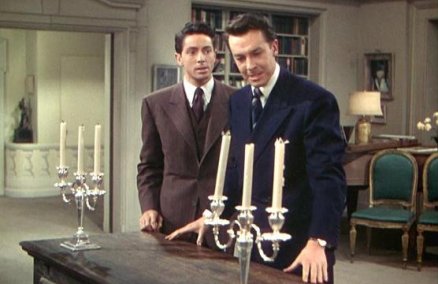In our safe and predictable arts climate, where most art exhibitions and theatrical plays are staged based on commercial viability, it’s enlightening to see a bunch of young artists who are sticking to their guns and doing their own thing. These artists are uncompromising in their artistic vision, and some have achieved nationwide acclaim through their impressive bodies of work over the years. They are a new breed of artists who are providing the edge in the local arts scene today, and will hopefully continue to push boundaries with critical acclaim. I-S profiles some of our very best.
The Young Gun: Brian Gothong Tan
Boyish 26-year-old multimedia artist Brian Gothong Tan first caught our attention in 2001 with his beautiful and stark lighting works in the play The Optic Trilogy, part of ACTION Theatre’s 42 Theatre Festival. Since then, he has gone on to create playful mesmerizing video and installation works that have graced the walls of Esplanade – Theatres on the Bay, Singapore Art Museum (SAM) and Sculpture Square, and been shown at the 9th Venice Architectural Biennale last year, to critical acclaim.
Tan has certainly come a long way from his early days creating low-budgeted videos that costs as little as $50, using cheap fluorescent tubes and found objects, and getting actors to work for free. “Today, I get much bigger funding, which means I can invest in better equipment and hire professional people to help me out,” he says. “But because I have been so used to working with so little funds, I am able to push the value of my funding to do more things and cut down on unnecessary costs. Besides, it’s really not about the money, but the ideas behind it. Even though the final product might look good and slick, if it doesn’t have a clear message, people will just walk away from it.”
Tan’s multi-faceted fantasy-like works, such as The Mysterious Book of Invisible Children exhibition at the Esplanade, Heavenly Cakes and Sentimental Flowers at SAM, and other video works like Psychoanalytical Neofeminist dwell into pop culture, juxtaposing images and sculptures of Astro Boy with experimental and edgy video imageries, featuring scenes that would not look out of place in a Final Fantasy video game or the movie Tron. “My work incorporates fashion elements as well as and borrows a lot from the MTV aesthetic, as opposed to more coolly intellectual and highbrow works in the local arts scene,” he explains. “I don’t shy away from fusing low and high culture together. I think it stems from the fact that I like a lot of things, like watching movies, drawing, photography etc., and I like to do a lot of things at once. So I merge these different disciplines quite naturally.”
Indeed, Tan’s works are some of the funkiest and freshest that we’ve seen, and his works are both accessible and cutting-edge too. A testament to his popularity: One of Tan’s Astro Boy sculptures from The Mysterious Book of Invisible Children was stolen a few days into the exhibition. ”Judging from public reaction, I think my works from that exhibition are the most acclaimed. It has something to do with the imagery I used, which was very youth-oriented. But I think the main appeal of my work was that it was accessible, that means when people on the street see it, they understand it or are able to engage with it on a certain level. Which I think is very important for art to function effectively.”
The Sound Man: George Chua
For a secondary school dropout, multidisciplinary artist George Chua has done well for himself. Not only has the 33-year-old established himself as one of Singapore’s most well-known sound and performance artists, he has also immersed himself in numerous theatrical projects, including TheatreWorks’ Balance (2004) and spell#7’s Beautiful Losers (2003). Chua even nabbed himself an honorable mention for special achievement in music for Balance at last year’s Life! Theatre Awards.
Not bad, considering Chua has only dabbled in the arts full-time since 1999. “Prior to that, I worked in the music industry for a while and DJ-ed in clubs, playing mostly indie rock tracks. But even as a kid, I was always into drawing and artistic things. I even studied Chinese painting for three years.”
Following his decision to go full-time, Chua joined his friend, multidisciplinary artist Zai Kuning, and his dance troupe, Metabolic Theatre Company, and was actively involved in dance and performance art for a good three years. But Chua’s numerous dance and theatrical contributions aside, it is his austere and absorbing sound art, which he has dabbled in since 2003, that sticks. So compelling are his moody sound works, Chua has even garnered a sizeable underground following. Among some of his most innovative works are I Have Escaped Even Myself, a collaborative music performance using laptop computers with Zai Kuning, Yuen Chee Wai, The Observatory’s Evan Tan, and Danish sound designers Lasse Mauhaug and John Hegre. Chua’s personal favorite is Lamentation for Uncle Song, the first in a series of many that explores the lives and imagination of a fictional theater director called, well, Uncle Song. It is an evocative and moody performance, conceptualized and directed by Chua, with the help of a female singer and mime artist. In some of the show’s quirkier segments, Chua introduces to audiences found objects that supposedly belonged to Uncle Song, adding to the show’s depth and dexterity, which will be further explored in the upcoming art exhibition The Unnamed Servant or The Goat Slayer in June.
Chua’s idiosyncrasies and quirks are just part of his multifaceted works. “They are all interconnected, from my earlier body movement works to my exploration of sound art,” he says. “The main thread that runs through my work is: where does sound come from? My works essentially explore the origin of sound … and try to understand and unravel its complexity. I want audiences to appreciate the implications that sound has: Socially, philosophically and spiritually.”
Chua’s next big project, alongside friends and longtime collaborators Yuen Chee Wai and Alvin Lim, is a sound and installation piece for the Singapore Biennale in November. “I will further explore the themes of inhabitation, and how sound basically inhabits space. It’s going to be mind blowing.”
The Unsung Hero: Zai Kuning
You must have heard of Zai Kuning. Or perhaps not. The reclusive and highly gifted 42-year-old multidisciplinary artist only recently took home the best sound accolade at the Life! Theatre Awards, but he has been a full-time artist for as long as he can remember. Zai, who employs a wide range of practices to his craft—from documentary video, poetry and dance to theater, music and performance art—has been consistently pushing the boundaries of contemporary art here and is certainly regarded as one of our most avant-garde practitioners.
The son of a musician father, Zai first discovered music and the arts when he was 16, even if he never had formal education at the time. “I was a wedding singer in the kampongs that I grew up in,” he says. “Thus, I was introduced to music at a very young age.” To further his interest in the arts, he studied ceramic art at LaSalle in 1985, before moving on to study natural chemicals in 1987 in Japan.
Following his return to Singapore in 1990, Zai joined the then influential art collective The Artists Village, founded by revered local painter and performance artist Tang Da Wu. “It was then that I started to know about performance art,” he says. “I learnt about the disciplines and techniques involved … and I began to lean towards dance and theater as a potential for me to express myself creatively.” It was a natural progression for Zai to set up his own art and dance company, Metabolic Theatre Laboratory (1994-1999), and immerse himself in various dance forms.
While garnering a strong following, Zai has never really received commercial acclaim until recently, which is a good thing, as his guerilla-like status lends his works the extra edge. Consider some of his more obscure and little known works: The highly personal documentary Riau (2000), which explores the lives of gypsies living in the Riau islands, the confounding Erocicism. Flower of Evil (2003) and the weird and entertaining Prodigal Song (1996), which featured male dancers prancing around in their underwear, was considered by many as a work that was ahead of its time. Zai’s most recent exhibition at Sculpture Square last year, the simple, yet disturbing Tree in a Room, is also one of his most impressive, as it featured a sinister looking solitary tree, possibly straight out of an episode from Tales from the Darkside.
“I feel like a nomad who is moving from river to river, changing myself accordingly, and doing different types of art,” Zai explains of his artistic instinct. “I really do prefer to do different things as I do not want to be involved in just one aspect of art.”
Like his fellow compatriot, George Chua, Zai also dabbles in sound art, and is as comfortable tempering with the guitar as performing in the dance form. For his upcoming Singapore Biennale piece, Zai will be creating a video and installation piece which has viewers strapped to a chair in a confined room, while a video featuring numerous arts figures lament the state of the arts. “It is a six-hour video, and those who want to watch it must watch the whole thing. There will be no alternative,” he says with a slight chuckle. With such an uncompromising approach towards art, no wonder Zai Kuning is regarded as one of our most longstanding underground artists, bar none.
The Puppet Master: Chong Tze Chien
Playwright, actor and director Chong Tze Chien has come a long way. While it was just six years ago in 2000 that the 31-year-old first entered the theater scene as Associate Playwright for The Necessary Stage (TNS), today the amicable Chong has managed to establish his own turf. Chong left TNS two years ago after working on notable projects such as Pan Island Expressway (2001) and Spoilt (2001), before joining the then fledgling puppetry and theater company The Finger Players in 2004, turning it around 180° degrees.
Helming as Company Director, Chong led the company into two major wins at the Life! Theatre Awards recently: Best Director for Between the Devil and the Deep Blue Sea (2006), and Production of the Year and Best Ensemble Acting for Furthest North, Deepest South (2005). From an obscure puppetry company that almost closed in 1998 because of financial crisis, The Finger Players has emerged as one of the most profiled and cutting-edge theater companies today.
“It was almost serendipitous as I had just left TNS, and I received a call from Players’ Artistic Director Tan Beng Tian on the day itself to work on a script,” says Chong. “The company had wanted to branch out from doing just children’s puppetry to adult theater. There was a change in artistic direction and management structure … and I was there.”
Chong’s first production for the company, the unanimously lauded Furthest North, Deepest South, about the travels of Chinese navigator Eunuch Cheng Ho, is a breath of fresh air in our stale theatrical arena. Fusing live-sized puppetry with stage actors and a minimal set, the $50,000 production (a small sum as most plays are staged from $80,000 onwards) is innovative for its unconventional approach to theater, and is a joyous watch from the get go, thanks to an entertaining script, also penned by Chong. His follow-up, the darker and more dramatic Between the Devil and the Deep Blue Sea, staged at The Arts House last year, also fuses puppetry to highlight the play’s darker themes such as alienation and deteriorating relationships.
“Usually, people associate puppets with something decisively childlike … but we manage to utilize the puppets to explore adult topics, changing perceptions on what makes local theater and puppetry,” says Chong, on what makes his plays tick. “Compelling theater is about telling good stories. All I want is to create works that people will remember and talk about in 10, perhaps 100, years from now.”
The Mad Scientist: Donna Ong
Don’t be fooled be her appearance. Pretty, diminutive artist Donna Ong may look like a sweetheart in person, but her intricate installation artworks and drawings are anything but. Most well known in the local arts circuit for her successful first solo exhibition Palace of Dreams last year, where she presented a series of detailed pencil drawings of insect wings as well as an installation, Ong is one of Singapore’s youngest, and possibly most morbid, local artists yet to emerge from the woodwork.
The 27-year-old architecture and arts graduate from University College London and Goldsmiths College, respectively, has had many group exhibitions in the UK prior to her return to Singapore. And it was then that she discovered her inner demons. “It took a while before I realized that I had a certain art style,” says Ong. “The tutors in UK helped a lot in gearing me towards where my artworks are now … which explore the themes of obsession, desire, faith and hope through the use of different personas.”
For the 2002 mixed media piece “Sing O Barren Woman,” for example, Ong constructed what looks like a project that Dr. Frankenstein would be proud of. The piece, which is reminiscent of a science laboratory, consisted of test tubes, jars, tubing and a children’s doll. Ditto the fantastic Pause, which took six months to conceive. The piece’s setup, which also doubles up as a work space for an imaginary obsessive compulsive scientist, delves into the subject of physical excess.
The same amount of obsession that Ong puts into her works, which usually takes a few months to complete, is equally fascinating. “It’s a way for me to relive certain roles, to be able to step out of myself, look at different situations and relish in them,” she explains. “My work is about adopting a certain identity … to live out what my characters would be thinking and doing. If I want to show the themes of belief and faith in my work, I should be reliving the themes myself. It’s about believing in something even though there is no reward. Like the famous philosopher Kierkegaard, who pretended to be different characters during his lifetime, you have to practice what you preach.”
For the upcoming Singapore Biennale in November, Ong will be showcasing three works at the Supreme Court in City Hall. It will be a dreamy and dark mélange of drawings, installations and other weird objects. “The works will center on the secret fantasies of three judges, and how they have their whims and fancies about caves, flying machines and Frankenstein complexes.” We can’t wait already.
The Necessary Newbie: Natalie Hennedige
While her previous performances with TNS were more emotionally wrought, it seems that Natalie Hennedige, who set up new theater company Cake Theatrical Productions in August last year, has now gotten the chip off her shoulders. At TNS, she was resident actress and director for plays such as Beginnning of the End (2002) and Abuse Suxx!!! (2002).
The chatty actress is extremely excited about her role as Artistic Director for her own theater company. “I got comfortable and stable after working with TNS for a few years,” explains Hennedige, on her decision to move on. “And when you work for a company that doesn’t belong to you, you are basically working for someone else … and working on their artistic vision, rather than your own. I wanted to do my own thing and challenge myself artistically.”
Hennedige’s directorial debut with Cake, the $170,000 Animal Vegetable Mineral last year, was a fun and sometimes serious tale about taking the leap of faith. Balancing comedic and dramatic elements, the second half of the play was particularly notable as its narrative became increasingly surreal and messy, but in a good way. “The plays that I want to make will reflect the name of the company itself, which is ‘cake,’ which is fun, sweet and sometimes unexpected with a lot of layers. I want to create very contemporary works, but without taking myself too seriously … focusing on pieces that are adventurous, unique and edgy, drawing on pop culture and suitable for the MTV generation.”
Hennedige’s latest work, Queen Ping, which was a collaboration with Esplanade’s The Studios series, is equally fun and infectious. The play centers on a dysfunctional family, and features talents such as visual artists Rizman Putra and Brian Gothong Tan, and actors Norlina Mohamed and Michael Corbridge. Brimming with an innovative stage design courtesy of Tan, who also acts in the play, Queen Ping is vibrant and memorable.
Next up for Hennedige and Cake: An adaptation of Sophocles’ classic Antigone, but reworked with a modern edge. “I know I took a huge risk starting Cake, especially learning the ropes in TNS and knowing how hard it is to run a theater company. But I knew I needed to put up all the stops and run with the idea. Hopefully, with the kind of multi-sensory plays that I am doing, audiences will find local theater fun again.”





























